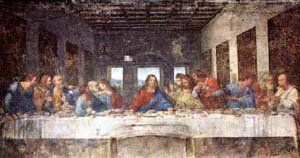|
Forget
Dan Brown... forget Da Vinci. For 2000 years, successive generations
have been gripped by the quest for the Holy Grail, a journey that
has brought people to some of the most historic and mysterious sites
in Britain.
by Stuart Carter

Did Christ drink from the Holy Grail at the Last Supper?
|
|
The very nature of the Holy Grail is surrounded by different stories. Some claim that it's the bowl that Joseph used to collect the blood of Jesus Christ when he was dying on the cross. Others claim that it's the cup that Christ drank from at the Last Supper. The search for the Grail has taken questors around the world, but one of the most enduring legends tells us that it was brought to Britain by Jesus Christ's great uncle, Joseph of Aramithea - a tin merchant who often travelled to Cornwall and Somerset to trade in precious metals. He is thought to have left on a voyage shortly after Christ's death, but this time is thought to have headed to Glastonbury - the Glass Isle he had been sent to find by the Archangel Raphael.
To this day, no evidence has been found and the quest continues to some of the most mysterious sites in Britain. In Glastonbury, it is said that the water flows red from the blood of Christ; Tintagel, is supposed to be the birthplace of King Arthur and home to Merlin; and the Rosslyn Chapel in Scotland, a sacred treasure trove, is thought to closely guard the holy secrets of the Grail. Where does legend end and history begin?
Buried in Glastonbury
Many people believe that Glastonbury is the most likely place where Joseph hid the Holy Grail. He is thought to have sailed with his companions to Wearyall Hill in Glastonbury - where suddenly his staff flourished into a living hawthorn bush, the Holy Thorn of Glastonbury. Joseph took this as a sign that this was the destined resting place of the Holy Grail. The 'Glastonbury Thorn' thrives to this day, and unlike any other thorn bush in the country, it flowers every Christmas and Easter. Each December, a flowering branch of the tree is cut off and sent to the Queen.

The Holy Thorn of Glastonbury - where Joseph might have placed the Holy Grail.
|
Back in the 12th century, 30 monks from the Abbey descended into the ancient tunnels underneath Glastonbury in search of the Grail. Only three came out - one struck dumb, and two deranged. The rest, it is said, were claimed by the mysterious forces of the hill. No one ever followed these monks into the labyrinth under Glastonbury, and the tunnels have long since been sealed off as the surface soil has slipped down the sides of the tor. But even today questors still dig for the warren of tunnels beneath Glastonbury, hoping to find the Holy Grail and the remains of Joseph of Aramithea.
Others are looking to the springs of Glastonbury, typically to one place where a spring runs red, according to legend, with the blood of Christ. The Chalice Well still exists today, and its water is still red, but the most likely explanation for the colour is the iron deposits in the water. Near to the Chalice Well there is another spring where the water is white - fed by underground caves beneath Glastonbury tor. Some believe that this is a much more likely hiding place where Joseph might have hidden the Holy Grail.
Ancient questors in Cornwall
Apart from the location of the Grail, many questors are drawn to the ultimate questor and legendary ruler of the Britons - King Arthur. He is often presented as a romantic medieval figure and arguments still rage about whether Arthur is a real or a mythical character. The first written reference to King Arthur is found in Geoffrey of Monmouth's 12th century book The History of the Kings of Britain. Most famously, Arthur, stands on the steps of Camelot Castle and dispatches his Knights on a great quest to find the Holy Grail. But the 'real' Arthur, the man who started all the legends, comes from the 5th century, a time with no written history - the Dark Ages.
Each year, over a million visitors come to the castle of Tintagel on the north coast of Cornwall in search of King Arthur and the Holy Grail. Some say Tintagel is 'Camelot' - the seat of King Arthur. Some say it belongs to Merlin, the wizard who masterminded Arthur's birth, rise to power and quest for the Holy Grail. The mysterious cave running right underneath Tintagel is said to be Merlin's Cave.
 Credit: Archaeology@Glasgow
Credit: Archaeology@Glasgow
The piece
of slate with the mysterious inscription uncovered at Tintagel.
|
Recent excavations have revealed dramatic new evidence about Tintagel during the 5th century - the time of the 'real' Arthur. Although less than a quarter of Tintagel has been excavated, incredible amounts of Mediterranean pottery have already been found. Could there be some basis for the legend placing Arthur at Tintagel? In 1998, a 5th century drain-cover was unearthed from the castle which bore an inscription that could change legend into history. The inscription translated as "Artnou made this". Is this the clue that historians, writers and grail-hunters have been searching for? Is Artnou, Arthur? Whatever the truth behind the 'Artnou' stone, it has added greatly to the legend.
The Grail in Scotland?
Moving from the south of the U.K. to Scotland, just a few miles from Edinburgh, is the Rosslyn Chapel. Since Dan Brown's book The Da Vinci Code, hundreds of thousands of visitors have been there - but even before his book, 34,000 visitors a year made the pilgrimage to Rosslyn to look for secret messages in the chapel and for the Holy Grail. Many are drawn to the Apprentice Pillar which has drawings of Joseph of Aramithea holding the Grail and a cross carved with the shape of the Grail on it. This has caused some scholars to believe that the chalice must be hidden inside the pillar. Metal detectors have shown an object of the right size to be inside, but the Earl of Rosslyn has repeatedly refused to allow the pillar to be X-rayed. His motto is "conservation and preservation, not excavation".
For the moment, the Apprentice Pillar must remain a mystery. But even if the Holy Grail isn't in the Pillar, there are those who say it can't be far away. Rosslyn glen has been a spiritual focus for thousands of years. There are natural caves along the banks of the river - some with Bronze Age markings. There is a network of tunnels under the castle, and no one knows how many catacombs beneath the Chapel. According to legend, treasure hunters sent a piper and his dog down this tunnel to explore the labyrinth. They could hear the music as the piper moved beneath them. He travelled for a mile and then the piping stopped. He never emerged, and no one has ever entered the tunnel since.
Perhaps it's this spirit of exploration that is more important than the answer itself. On their quest to find the Holy Grail, the Knights of the Round Table would only achieve enlightenment if they asked the right question of the cup: "Whom doth the Grail Serve?" There are many who believe there is no chalice - that the Holy Grail is the quest itself; and that it is the quest, rather than the cup, which brings the gift of ultimate enlightenment.
For more information:
BBC - The never-ending search
http://news.bbc.co.uk/1/hi/magazine/4044765.stm
Tintagel Excavations 1998
http://www.gla.ac.uk/archaeology/projects/tintagel/
|
